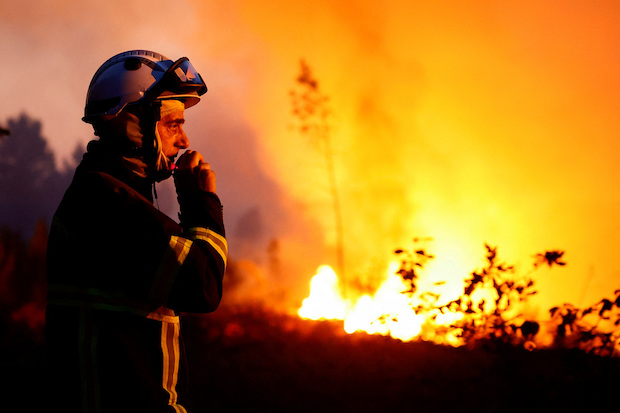
A firefighter works to contain a tactical fire in Louchats, as wildfires continue to spread in the Gironde region of southwestern France, July 17, 2022. (REUTERS/Sarah Meyssonnier)
MADRID/LISBON — A heatwave sweeping southern Europe that has caused hundreds of deaths and huge wildfires showed some signs of abating on Monday but continued to move north, including towards Britain where authorities issued an extreme weather warning.
Much of Europe is baking in a heat wave that scientists say is consistent with climate change and has pushed temperatures into the mid-40s Celsius (over 110°F) in some regions, with wildfires raging across the tinder-dry countryside in Portugal, Spain, and France.
Temperatures in some parts of southern Europe began to ease over the weekend but thousands of firefighters across the region still battled to contain hundreds of wildfires and authorities said the risk of further blazes remained extremely high.
Spain was facing the eighth and last day of a more than week-long heat wave on Monday, which caused more than 510 heat-related deaths, according to estimates from the Carlos III Health Institute.
With fires burning thousands of hectares in Galicia, Castille and Leon, Catalonia, Extremadura, and Andalusia, Spain mourned the death of one firefighter in the northwestern province of Zamora on Sunday evening. Almost the entire country faces an extreme fire risk.
In El Pont de Vilomara in Catalonia, evacuees gathered outside a civic center, among them retiree Onofre Munoz, 69, who said that his home and van had been completely destroyed.
“We bought the van when I retired and now it’s totally scorched. We have nothing,” he said.
Our house had quite a few windows, they exploded, and a powerful flame came inside. We knew it yesterday afternoon because we got some pictures in which we saw everything had burned.”
More than 70,000 hectares (173,000 acres) have burnt in Spain so far this year, the worst year of the last decade, according to official data. Last month, a huge wildfire in Sierra de la Culebra, Castille and Leon, ravaged about 30,000 hectares of land.
Spain also reported a second death caused by a wildfire after a fireman died on Sunday. A 69-year-old was found dead on Monday in Ferreruela, in an area burned by flames, emergency authorities said. Local media said it was a farmer.
In Portugal, temperatures dropped over the weekend, but the risk of wildfires remained very high across most of the country, according to the Portuguese Institute of Meteorology (IPMA).
More than 1,000 firefighters, backed by 285 vehicles and 14 aircraft, were battling nine ongoing wildfires, mainly in the country’s northern regions, authorities said.
National emergencies
Belgium and Germany were among the countries expecting the heatwave to hit them in the coming days.
The European Union said it was monitoring closely wildfires raging in southern member states on Monday, sending a firefighting plane to Slovenia over the weekend adding to recent deployments to France and Portugal.
“We continue of course to monitor the situation during this unprecedented heatwave and will continue to mobilize support as needed,” spokesperson Balazs Ujvari told a briefing.
The EU was also providing satellite imagery to France, he added. Separately, the Commission announced in a report that almost half the territory of the bloc was currently at risk of drought.
Britain was on course for its hottest day on record on Monday with temperatures forecast to hit 40°C for the first time, forcing train companies to cancel services, schools to close early and ministers to urge the public to stay at home.
The government has triggered a “national emergency” alert as temperatures were forecast to surpass the 38.7°C (102°F) recorded in the Cambridge University Botanic Garden in 2019 on Monday and Tuesday.
“We hoped we wouldn’t get to this situation but for the first time ever we are forecasting greater than 40°C in the UK,” climate attribution scientist at the Met Office, Dr. Nikos Christidis, said.
“Climate change has already influenced the likelihood of temperature extremes in the UK. The chances of seeing 40°C days in the UK could be as much as 10 times more likely in the current climate than under a natural climate unaffected by human influence,” he said.
In the Gironde region in southwestern France, the fires had destroyed 14,800 hectares (37,000 acres), local authorities said on Monday. More than 14,000 people have been evacuated from the area. France has issued red alerts, the highest possible, for several regions, with residents urged “to be extremely vigilant”.
In Italy, where smaller fires have blazed in recent days, forecasters expect temperatures above 40°C in several regions in the coming days.
Switzerland also suffered the effects of the heatwave. Axpo, the operator of the Beznau nuclear plant, said it on Monday it was forced to reduce output so that it does not overheat the Aare river from which it draws its cooling water.
The Swiss government issued a heat wave advisory, citing considerable danger across much of the country with temperatures in some parts reaching 36°C (96.8°F).
RELATED STORIES
‘Climate change affects everyone’: Europe battles wildfires in intense heat
Wildfires rage in France, Spain as heatwaves sear Europe
Scorching heatwave sparks wildfires in Europe